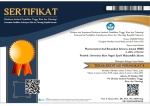Pengaruh Intervensi terhadap Kepatuhan Penggunaan Analgesik Opioid dan Skala Nyeri Pasien Kanker
Abstract
Keywords
References
Bennett, M. I., Bagnall, A. M. and José Closs, S. (2009) ‘How effective are patient-based educational interventions in the management of cancer pain? Systematic review and meta-analysis’, Pain. International Association for the Study of Pain, 143(3), pp. 192–199. doi: 10.1016/j.pain.2009.01.016.
Van Den Beuken-Van Everdingen, M. H. J. et al. (2016) ‘Update on Prevalence of Pain in Patients with Cancer: Systematic Review and Meta-Analysis’, Journal of Pain and Symptom Management. Elsevier Inc, 51(6), pp. 1070-1090.e9. doi: 10.1016/j.jpainsymman.2015.12.340.
Damodar, G. et al. (2014) ‘Reasons for low quality of life in south Indian cancer patient population: A prospective observational study’, Indian Journal of Pharmaceutical Sciences, 76(1), pp. 2–9.
Kementerian Kesehatan Republik Indonesia (2018) ‘Laporan Nasional RISKESDAS 2018’, Kementrian Kesehatan RI, pp. 1–582. Available at: https://dinkes.kalbarprov.go.id/wp-content/uploads/2019/03/Laporan-Riskesdas-2018-Nasional.pdf.
van Leeuwen, M. et al. (2018) ‘Understanding the quality of life (QOL) issues in survivors of cancer: Towards the development of an EORTC QOL cancer survivorship questionnaire’, Health and Quality of Life Outcomes. Health and Quality of Life Outcomes, 16(1), pp. 1–15. doi: 10.1186/s12955-018-0920-0.
Lovell, M. R. et al. (2010) ‘A randomized controlled trial of a standardized educational intervention for patients with cancer pain’, Journal of Pain and Symptom Management. Elsevier Inc, 40(1), pp. 49–59. doi: 10.1016/j.jpainsymman.2009.12.013.
Oldenmenger, W. H. et al. (2011) ‘A combined pain consultation and pain education program decreases average and current pain and decreases interference in daily life by pain in oncology outpatients: A randomized controlled trial’, Pain. International Association for the Study of Pain, 152(11), pp. 2632–2639. doi: 10.1016/j.pain.2011.08.009.
Oldenmenger, W. H. et al. (2018) ‘A systematic review of the effectiveness of patient-based educational interventions to improve cancer-related pain’, Cancer Treatment Reviews. The Author(s), 63, pp. 96–103. doi: 10.1016/j.ctrv.2017.12.005.
Savas, M., Bayraktar-Ekincioglu, A. and Celebi, N. (2020) ‘An evaluation of cancer patients’ opinions about use of opioid analgesics and the role of clinical pharmacist in patient education in Turkey’, International Journal of Clinical Pharmacy. Springer International Publishing, (0123456789). doi: 10.1007/s11096-020-01098-x.
Shavira, R. F., Andrajati, R. and Putri, R. A. (2021) ‘Analysis of the Effectiveness of Counseling and Digital Booklet By Pharmacist on Adherence and Pain Control of Cancer Patients At Dharmais Cancer Hospital’, Asian Journal of Pharmaceutical and Clinical Research, 14(8), pp. 124–128. doi: 10.22159/ajpcr.2021.v14i8.42167.
Sugiyono (2013) Metode Penelitian Kuantitatif, Kualitatif, dan R&D. Bandung: Penerbit Alfabeta.
Vähämäki, V. (2015) Medication Adherence and Drug Interactions in Cancer Pain, University of Eastern Finland.
Vos, T. et al. (2017) ‘Global, regional, and national incidence, prevalence, and years lived with disability for 328 diseases and injuries for 195 countries, 1990-2016: A systematic analysis for the Global Burden of Disease Study 2016’, The Lancet, 390(10100), pp. 1211–1259. doi: 10.1016/S0140-6736(17)32154-2.
World Health Organization (2018) WHO guidelines for the pharmacological and radiotherapeutic management of cancer pain in adults and adolescents, World Health Organization.
Yap, A. F., Thirumoorthy, T. and Kwan, Y. H. (2016) ‘Medication adherence in the elderly’, Journal of Clinical Gerontology and Geriatrics. Elsevier Taiwan LLC, 7(2), pp. 64–67. doi: 10.1016/j.jcgg.2015.05.001.
DOI: 10.15408/pbsj.v3i2.23682
Refbacks
- There are currently no refbacks.






